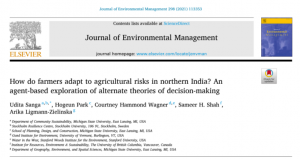
Abstract: Agricultural decision-making processes occur in complex and dynamic environments and are highly contextual. Despite evidence to the contrary, utility maximization is often the implicit theoretical assumption underlying agricultural decision-making processes. This study undertakes an exploratory approach to test alternative theories of human decision-making on the process of agricultural adaptation of farmers in India by synthesizing multiple sources of social and environmental data. We developed an empirical agent-based model (ABM) to simulate past adoption decisions of six agricultural adaptation strategies of 959 farmers in northern India. The model assessed the fit of four major decision-making rules – utility maximization, self-satisficing, social norms, and random choice for farmers differentiated by farm size. Scenario analysis was conducted to test whether (and which) alternative decision-making rules offered a better explanation of the adoption of (which) adaptation strategies. Results demonstrated that the utility-maximizing decision rule had a higher fit for productivity enhancing adaptation strategies, such as adopting high yield varieties and enhanced fertilizer use, with model performance increasing, generally, with farm size. The adoption of climate tolerant varieties by farmers was most closely guided by self-satisficing and social norms decision-rules, with the model performance, under both scenarios, highest for marginal landholders. Marginal farmers are more likely to use these heuristics to adopt climate tolerant varieties as their decisions may not necessarily be geared towards increasing profit, unlike larger farmers. Social norms had a higher fit for the adoption of climate-related strategies, including enhanced irrigation, with model fit increasing, generally, with farm size. Agricultural policy and extension efforts that incorporate the varied motivations and heuristics of agricultural decision-making, rather than assuming adaptation as a utility maximization exercise, can better design, develop, and disseminate solutions to support the adaptive capacity of farmers.
Sanga, U., Park, H., Wagner, C. H., Shah, S. H., & Ligmann-Zielinska, A. (2021). How do farmers adapt to agricultural risks in northern India? An agent-based exploration of alternate theories of decision-making. Journal of Environmental Management, 298, 113353. https://doi.org/10.1016/j.jenvman.2021.113353
The article is available to access here.